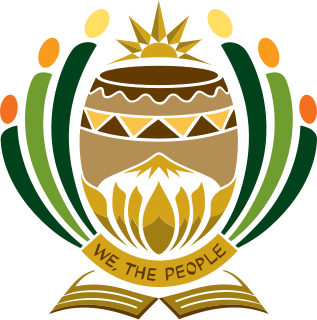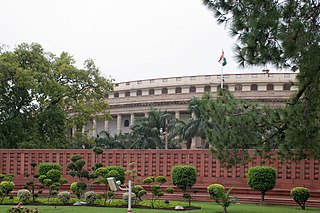
The Parliament of South Africa is South Africa's legislature and under the country's current Constitution is composed of the National Assembly and the National Council of Provinces.

The Victorian Legislative Council (VLC) is the upper house of the bicameral Parliament of Victoria, Australia; the lower house being the Legislative Assembly. Both houses sit at Parliament House in Spring Street, Melbourne. The Legislative Council serves as a house of review, in a similar fashion to its federal counterpart, the Australian Senate. Although it is possible for legislation to be first introduced in the Council, most bills receive their first hearing in the Legislative Assembly.

The Parliament of Pakistan is the federal and supreme legislative body of Pakistan. It is a bicameral federal legislature that consists of the Senate as the upper house and the National Assembly, as the lower house. According to the constitution of Islamic Republic of Pakistan, the President of Pakistan is also a component of the Parliament. The National Assembly is elected for a five-year term on the basis of adult franchise and one-man one-vote. The tenure of a Member of the National Assembly is for the duration of the house, or sooner, in case the Member dies or resigns. The tenure of the National Assembly also comes to an end if dissolved on the advice of the Prime Minister or by the president in his discretion under the Constitution.
Elections in South Africa are held for the National Assembly, provincial legislatures and municipal councils. Elections follow a five-year cycle, with national and provincial elections held simultaneously and municipal elections held two years later. The electoral system is based on party-list proportional representation, which means that parties are represented in proportion to their electoral support. For municipal councils there is a mixed-member system in which wards elect individual councillors alongside those named from party lists.

Parliamentary elections were held in Iraq on 30 January 2005 to elect the new National Assembly, alongside governorate elections and a parliamentary election in Iraqi Kurdistan. The 275-member legislature had been created under the Transitional Law during the international occupation. The newly elected body was given a mandate to write a new constitution and exercise legislative functions until the new constitution came into effect. The elections also led to the formation of the Iraqi Transitional Government.

Elections in Kenya take place within the framework of a multi-party democracy and a presidential system. The President, Senate and National Assembly are directly elected by voters, with elections organised by the Independent Electoral and Boundaries Commission (IEBC).

Elections in Southern Rhodesia were used from 1899 to 1923 to elect part of the Legislative Council and from 1924 to elect the whole of the Legislative Assembly which governed the colony. Since the granting of self-government in 1923, Southern Rhodesia used the Westminster parliamentary system as its basis of government. The Political party that had most of the seats in the Legislative Assembly became the government. The person in charge of this bloc was the Premier, later renamed Prime Minister, who then chose his cabinet from his elected colleagues.

The Alabama Legislature is the legislative branch of the state government of Alabama. It is a bicameral body composed of the House of Representatives and Senate. It is one of the few state legislatures in which members of both chambers serve four-year terms and in which all are elected in the same cycle. The most recent election was on November 6, 2018. The new legislature assumes office immediately following the certification of the election results by the Alabama Secretary of State which occurs within a few days following the election.

The Central Legislative Assembly was the lower house of the Imperial Legislative Council, the legislature of British India. It was created by the Government of India Act 1919, implementing the Montagu–Chelmsford Reforms. It was also sometimes called the Indian Legislative Assembly and the Imperial Legislative Assembly. The Council of States was the upper house of the legislature for India.

The House of Assembly was the lower house of the Parliament of South Africa from 1910 to 1981, the sole parliamentary chamber between 1981 and 1984, and latterly the white representative house of the Tricameral Parliament from 1984 to 1994, when it was replaced by the current National Assembly. Throughout its history, it was exclusively constituted of white members who were elected to office predominantly by white citizens, though until 1960 and 1970, respectively, some Black Africans and Coloureds in the Cape Province voted under a restricted form of suffrage.

The Tamil Nadu Legislative Assembly alone has powers to legislate laws covering state subjects in the Indian state of Tamil Nadu. It has a strength of 235 members of whom 234 are democratically elected using the First-past-the-post system. The remaining member is nominated as a representative of the Anglo-Indian community. The presiding officer of the Assembly is called the Speaker. The term of the Assembly is five years unless it is dissolved earlier.

General elections were held in East Africa Protectorate in March and April 1920, the first elections in the country. The Legislative Council had previously consisted entirely of appointed members. The new Council consisted of 11 elected white members, two appointed members representing the Indian population and one appointed member representing the Arab population, as well as a number of appointees by the Governor. This allowed the Council representative, although not responsible government. The territory became Kenya Colony on 23 July.

General elections were held in Kenya Colony on 12 February 1927.

General elections were held in Kenya Colony in 1931. Five of the eleven white seats in the Legislative Council were uncontested, with Lord Delamere amongst those returned unopposed. Unlike previous elections, which were boycotted by the Indian population, this time the community participated. Fourteen candidates including two independents contested the five Indian seats. However, seven of them declared that they would not take their seats on the Council if elected until the separate voter rolls for whites and Indians were scrapped.

General elections were held in Kenya Colony in 1934, with the first seats elected on 28 March. Four candidates were returned unopposed in the eleven Europeans constituencies, whilst the remaining seven constituencies were contested by 18 candidates. For the five Indian seats, there were 17 candidates. Voter turnout in the White seats was the highest since elections were introduced. The Council convened for the first time after the election on 24 April.

General elections were held in Kenya in 1952.
Legislative Council elections were held in Mandatory Palestine in February and March 1923. However, due to an Arab boycott of the elections called by the fifth Palestine Arab Congress, the results of the election were annulled, and an Advisory Council was appointed instead.

Legislative Council elections were held in Burma on 21 November 1922, the first in the country's history.

The Legislative Council of Kenya (LegCo) was the legislature of Kenya between 1907 and 1963. It was modelled on the Westminster system. It began as a nominated, exclusively European institution and evolved into an electable legislature with universal suffrage. It was succeeded by the National Assembly in 1963.












